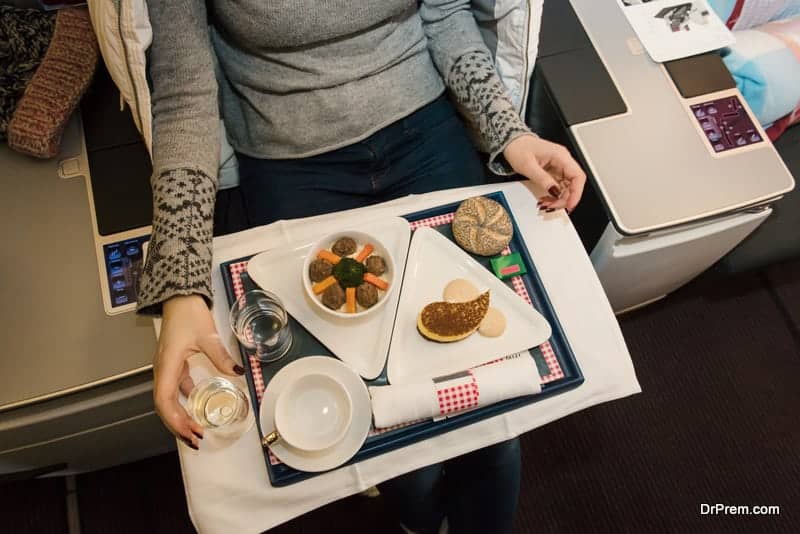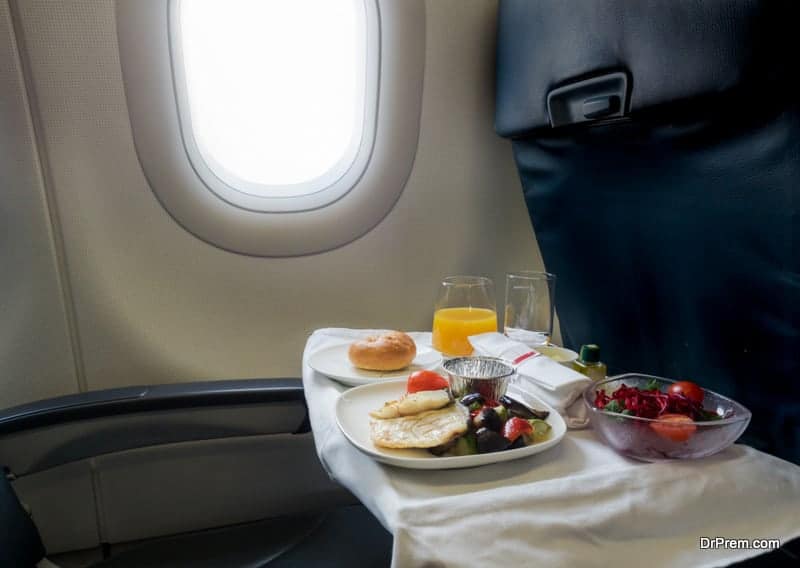As there are a majority of people who travel in airplanes from one place to another, there is a risk of food allergy during their air travel. Allergic reactions or airplane food allergy attack are most often caused by some kind of eatables such as peanuts, tree nuts, or seafood.
The treatment of allergic reactions in flight is of major concern and the flight staff must take it as a challenge. The strategies for prevention of allergic reactions onboard must be planned as early as possible. The passengers who are at risk of these allergies and reactions must be well aware of the prevention methods.
Airplane food allergy attack:
It is studied that medical emergencies take place 1 per 11000 passengers or say once in every 604 flights. The WAO (World Allergy Organization) has recommended these steps for prevention regarding food allergies and air travel:
- Passengers having asthmatic allergies: They should be provided with oxygen and bronchodilator for inhalation. These allergies comprise from moderate to severe symptoms. Bronchodilator can be used for moderate allergy, whereas for severe one, intramuscular or intravenous corticosteroid and intramuscular epinephrine can be used.
- Passengers having allergic emergencies: In these kinds of food allergies and air travel, whether mild, moderate, or severe, intramuscular epinephrine is recommended to be injected in the interior lateral thigh of the passenger. In case there is a need for a double dose, precautions can be taken to repeat it wherever necessary.
Types of airplane food allergy attacks while air travel:
Peanut allergy: Peanut allergy is basically a kind of food allergy caused due to peanuts. Many people are confused as to how to deal with peanut allergy on plane. The basic symptoms would be itchiness or may be hives, swelling, sneezing, abdominal pain, diarrhea, etc.
- Tree nut allergy: Some people are mistaken that tree nut allergy is limited to almonds only. But the truth is that tree nut allergy includes brazil nuts, cashews, macadamia nuts, shea nuts, walnuts pine nuts, etc. The difference between peanuts and tree nuts is that peanut is just a legume whereas tree nut includes almost all kind of hard shell nuts.
- Shellfish allergy: About 60% of people who suffer from shellfish allergy experience their first allergy as adults. Shellfish are categorized into two groups known ascrustacean(including shrimps, crabs) and mollusks (clams, oysters ).
Airplane allergy policies:
- British Airways: These airways can never guarantee a nut-free In fact, nuts are being served to the onboard passengers. In case of a request, they may or may not suspend the sale of these nuts on board. You need to fend for yourself in case of an airplane food allergy attack.
- Emirates: Emirates,too, serve nuts as an ingredient of the meal, and if not so, it is accompanied by some kind of soft drink. There is not at all an option for a special meal, on top of it passengers are requested to bring their own food.
- Qantas: These airplane line removed peanuts from almost all of its flights and minimized the use of peanuts in any kind of food product which is to be served to the passengers who are on board. Other nuts have a possibility of being served. It cannot guarantee an allergy-free Special meals are available.
- Qatar: In these airline, people with chances of airplane food allergy attacks are expected to fill a MEDIF information form 48 hours prior to their flight, and they are requested to bring their own meals.
- American Airlines: American airlines do not serve any peanuts or peanut-related meals as well as permission to halt is not granted. They take their guarantee but not the passengers’ as they may bring peanuts on board. In short, even American airlines do not provide a nut-free flight considering allergies and food intolerance while flying.
- Air France: These airlines provide allergen-free meal only on basis of prior knowledge and requested an accommodation. It might be subject to availability depending on the destination.
Prevention of onboard allergy:
- It is recommended to inform your airlines in advance regarding your allergy and how to deal with peanut allergy on plane. According to a study, it is noticed that making the allergy known to the staff and seeking accommodation results in a reduction of the chances of an allergy. Once an individual is aboard the plane, it is their duty to check the trays, tables, armrests,and
- We need to see to it that the adrenaline pen is nearby and if, in case of emergency, we can get easy access to it. In case you face an airplane food allergy attack, inform the air staff and attendants, and use the adrenaline.
- Airline flight crew must immediately contact a doctor on board, if any, to check what is the condition of the passenger and whether the plane needs to be moved to the closest airport.
Measures to reduce this food exposure played an important role in reducing allergic reactions of the onboard passengers. There is also a limitation to this, many flights do not follow these measures for allergies and food intolerance while flying for different reasons. It may be higher costs, some kind of difficulty, or discomfort, or any other commercial reason.
A passenger can help himself fight an airplane food allergy attack by:
- Requesting some special accommodation.
- They must see to it that they are consuming peanut-free meals.
- One must himself clear the armrests, trays, etc.
- Also, care must be taken to avoid using pillows and blankets provided by airplanes.
- Move to zones where no one is consuming such nuts, or request them to not eat such products.
- In the end, it is safest to not consume meals provided by the airplane.
CONCLUSION:
Studies show that allergic reaction is quite common in airplanes. About 9% of people with peanut allergy find some kind of allergic reactions during a flight. There are a handful of measures to deal with an airplane food allergy attack.
A CAA representative said that they believed the findings regarding allergies and reactions would be helpful to them for planning strategies for prevention and providing aid for it. The aviation industry specialists are aiming at determining the nature of these risks. The aviation industry is ready to welcome any evidence-based guidance but in response, it should help in preventing such allergic reactions related risks.









